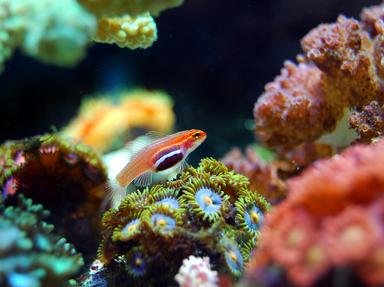Quiz Answer Key and Fun Facts
1. Coral was originally defined by Aristotle as "zoophyta" meaning "plant-animal". Until the 1800s this was the general belief until William Herschel was able to identify which particular animal characteristic?
2. Coral is made up of thousands of genetically identical little creatures which have which medical sounding name?
3. The individual parts of coral have been known to eat passing fish and plankton. What surrounds the central mouth opening to aid in feeding?
4. Like the African lungfish, coral can remain dormant out of water. When rehydrated, it will come to life again.
5. Coral reproduction can be both sexual and asexual. Synchronous spawning is a common form of reproduction whereby gametes are simultaneously released into the water. These gametes then fuse to form a larva. What time of day does this mass spawning ordinarily take place?
6. Soft corals and hard corals are different in that hard coral has a stony skeleton which is excreted from the base. It is made up of which chemical compound?
7. Coral reefs are under threat worldwide from a number of environmental changes as well as man-made threats. Which of the following is *not* hypothesised as endangering the existence of coral?
8. Coral has many medicinal uses. Treatments for asthma, arthritis as well as cancer have been developed from it. Which medical replacement procedure can use coral as part of the process?
9. Coral is very versatile and has even been used as a building material. St. George's Tower of Oxford Castle in England was constructed using coral as one of its components. Where did the coral come from?
10. The Cambrian period held the first appearance of corals, over 540 million years ago. The Cambrian period is the first geological time period of which Era?
Source: Author
kino76
This quiz was reviewed by FunTrivia editor
Tizzabelle before going online.
Any errors found in FunTrivia content are routinely corrected through our feedback system.


